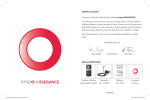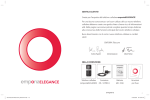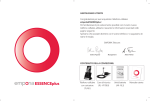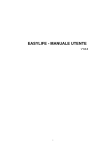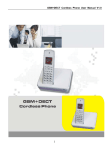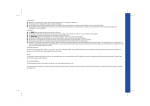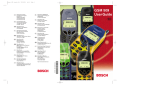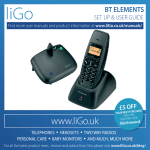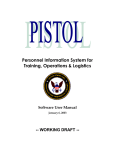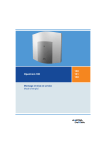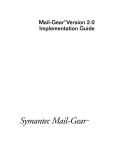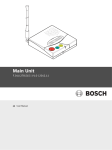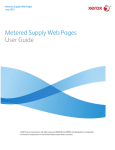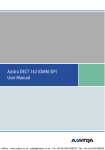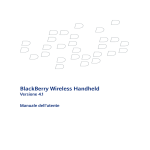Download Aastra 312 Manual
Transcript
Aastra Phone 312 User Guide VoIPon www.voipon.co.uk [email protected] Tel: +44 (0)1245 808195 Fax: +44 (0)1245 808299 Welcome to Aastra Thank you for choosing an Aastra product. Our product stands for the highest quality demands, teamed with first-class design. This instruction manual will guide you in the use of your Aastra Phone 312, and in doing so will answer all of your important questions. If you should require any additional technical support, or if you would like information about other Aastra products please contact the person responsible for your system or your retailer first. You can also use our website www.aastra.com to find any further information. We hope that you will enjoy using your Aastra Phone 312. VoIPon www.voipon.co.uk [email protected] Tel: +44 (0)1245 808195 Fax: +44 (0)1245 808299 Contents Using the phone........................................................................................................................1 Safety instructions ………………………………………………………………………1 Correct use/declaration of conformity……………………………………………………1 Electricity supply/power failure/battery …………………………………………………1 Safety …………………………………………………………………………………1 Overview and basic information …………………………………………………………3 General ………………………………………………………………………………3 Details regarding standby and talk times ………………………………………………3 Reach …………………………………………………………………………………4 PIN protection …………………………………………………………………………4 MEM card ……………………………………………………………………………4 Headset connection ……………………………………………………………………4 Diagram ...................................................................................................................................5 Buttons on the handset……………………………………………………………………6 Installation ...............................................................................................................................7 Unpacking and installing the phone ………………………………………………………7 Unpacking ……………………………………………………………………………7 Installing the charging point ……………………………………………………………7 Putting the charging point into operation …………………………………………………8 Putting handset into operation ……………………………………………………………9 Precautions when handling the battery …………………………………………………9 Precautions during use ………………………………………………………………10 Initial operation ………………………………………………………………………10 Charging and use times ………………………………………………………………11 Inserting the battery …………………………………………………………………11 Inserting the MEM card ………………………………………………………………12 Removing the MEM card ………………………………………………………………12 Battery: Battery status …………………………………………………………………13 Battery warning ………………………………………………………………………13 Logging on the handset …………………………………………………………………14 Attaching/removing the belt clip …………………………………………………………14 Display screen, softkeys and buttons .....................................................................................15 The display ……………………………………………………………………………15 Text …………………………………………………………………………………16 Softkey row …………………………………………………………………………16 Illumination …………………………………………………………………………16 Softkeys and buttons ……………………………………………………………………17 Softkey: Arrow keys……………………………………………………………………17 Softkey: OK …………………………………………………………………………17 Softkey: Back …………………………………………………………………………17 Softkey: Redialing ……………………………………………………………………17 Handset button ………………………………………………………………………18 Loudspeaker button …………………………………………………………………18 Info button (i)…………………………………………………………………………18 i VoIPon www.voipon.co.uk [email protected] Tel: +44 (0)1245 808195 Fax: +44 (0)1245 808299 Contents C button ……………………………………………………………………………18 Signal button (R)………………………………………………………………………19 # button………………………………………………………………………………19 * button………………………………………………………………………………19 Number buttons ………………………………………………………………………19 Softkey: Menu ………………………………………………………………………19 Automatic fade out………………………………………………………………………20 Navigating the menu ..............................................................................................................21 Example: The main menu ………………………………………………………………21 Example: Telephone book/editor …………………………………………………………23 The editor ………………………………………………………………………………24 Enter names/call numbers ……………………………………………………………24 Basic functions ........................................................................................................................25 Switching the handset on/off ……………………………………………………………25 Key lock…………………………………………………………………………………26 Turning the key lock on ………………………………………………………………26 Turning the key lock off ………………………………………………………………26 Switching the hands-free function on/off …………………………………………………26 Setting the handset volume during a conversation ………………………………………27 Switching the ringer off …………………………………………………………………27 Setting the ringer during a call……………………………………………………………27 Handset not attainable …………………………………………………………………27 Illumination ……………………………………………………………………………27 Change the display contrast ……………………………………………………………28 Handset secrecy button …………………………………………………………………28 Calling.....................................................................................................................................29 Dialing the call number …………………………………………………………………29 Dialing call number with predial ………………………………………………………29 Dialing call number with direct dialing …………………………………………………29 Calling from the redialing list ……………………………………………………………30 Calling from the telephone book …………………………………………………………31 Calling from the caller list ………………………………………………………………32 Accepting calls …………………………………………………………………………33 Putting a conversation on hold …………………………………………………………34 Accept call waiting ………………………………………………………………………34 Calling another contact during a conversation ……………………………………………35 Making a query call ……………………………………………………………………35 During the query: Toggle ……………………………………………………………36 Transferring a call ………………………………………………………………………36 The telephone book ................................................................................................................37 New entry ………………………………………………………………………………37 Editing an entry …………………………………………………………………………38 ii VoIPon www.voipon.co.uk [email protected] Tel: +44 (0)1245 808195 Fax: +44 (0)1245 808299 Contents Phone settings ........................................................................................................................39 Menu: Audio ……………………………………………………………………………39 Menu: Display …………………………………………………………………………41 Menu: Phone options ……………………………………………………………………42 Menu: Call diversion ……………………………………………………………………45 Menu: Alarm ……………………………………………………………………………46 WLAN: Registering a handset ..................................................................................................47 Setting up a WLAN profile ………………………………………………………………47 Selection via Site survey ………………………………………………………………47 Manual configuration …………………………………………………………………48 After the configuration ………………………………………………………………50 Changing the profiles …………………………………………………………………51 Setting up a SIP server.............................................................................................................52 Changing accounts ……………………………………………………………………54 Tools for troubleshooting/info ................................................................................................55 Ping ……………………………………………………………………………………55 Traceroute ………………………………………………………………………………56 Site survey ………………………………………………………………………………57 Roaming info ……………………………………………………………………………58 Info (on the network connection) ………………………………………………………58 Info (on the SIP server) ………………………………………………………………59 Syslog …………………………………………………………………………………60 Software update/licenses/PIN .................................................................................................61 Version …………………………………………………………………………………61 Update …………………………………………………………………………………61 Licenses ………………………………………………………………………………62 Changing the administrator PIN …………………………………………………………62 Reset.......................................................................................................................................63 Deleting the MEM card …………………………………………………………………63 Deleting the local telephone book ………………………………………………………63 Appendix.................................................................................................................................64 Free software ……………………………………………………………………………64 Warranty ……………………………………………………………………………64 Supported DHCP options ………………………………………………………………65 DHCP options supported by the Aastra Phone 312 ………………………………………65 Used producer-dependent options (vendor specific information) ………………………65 Supported country codes………………………………………………………………66 Questions and answers …………………………………………………………………67 Net traffic in idle state …………………………………………………………………67 Operation behind a firewall or a DSL router ……………………………………………67 What is the difference between user name, user ID and authentication name? ……………67 iii VoIPon www.voipon.co.uk [email protected] Tel: +44 (0)1245 808195 Fax: +44 (0)1245 808299 Contents Servicing and maintenance ………………………………………………………………68 Environmental characteristics and disposal ………………………………………………68 Advice for disposal ……………………………………………………………………68 Declaration of conformity ………………………………………………………………69 Technical data …………………………………………………………………………70 Menu tree ………………………………………………………………………………71 Index……………………………………………………………………………………72 iv VoIPon www.voipon.co.uk [email protected] Tel: +44 (0)1245 808195 Fax: +44 (0)1245 808299 Using the phone Safety instructions Correct use/declaration of conformity The Aastra Phone 312 is a handset for calling via SIP in a WLAN. The CE mark on the product confirms its conformity to the technical guidelines for user safety and electromagnetic compatibility, valid at the time of issuing the corresponding declaration of conformity according to European directive 99/5/EC. The declaration of conformity can be viewed online at http://www.aastra.com. Like every cordless phone, this handset uses radio signals which do not always guarantee a connection establishment in all circumstances. Therefore as a rule you should never rely solely on cordless phones for essential communication (e.g. medical emergencies). Electricity supply/power failure/battery This product requires an AC supply for the use of the charging point. The electricity can only be disconnected from the charging point when the mains adapter is taken out of the socket. If there is a power failure, all saved information (program and user data) is retained without changes. Important advice on the battery can be found in the section “Precautions when handling the battery”. Safety The charging point can only be installed and used in a closed building. Place the charging point on a non-slip mat. Do not install the charging point and the handset near: • Water, moisture or damp areas (e.g. bathroom) • Sources of heat, direct sunlight or unventilated areas • Devices, which produce strong magnetic fields, electronic devices, fluorescent lamps, computers, radio devices, televisions or fax/phone devices • Areas where the device could be covered, or where its ventilation could be obstructed, or where water could run into it • Dusty areas, and areas which are subject to vibrations, jolting or extreme temperature fluctuations. 1 VoIPon www.voipon.co.uk [email protected] Tel: +44 (0)1245 808195 Fax: +44 (0)1245 808299 Using the phone The following advice must be observed without fail when installing, connecting and operating the phone: • Position the connecting cable where it will not cause accidents. • Only connect the connecting cable to the intended sockets. • Only connect authorized accessories. • Only use the mains adapter plug supplied (ID no.: 4515303). • Research has shown that in certain cases portable phones, which are switched on, can influence medical devices. Therefore when using portable phones within medical facilities, comply with the regulations of the institution concerned. • Never - open the charging point or the handset (except for the battery cover) yourself. - touch the plug contacts with sharp or metallic objects. - carry the charging point by the connecting cable. • Only clean your telephone with a slightly damp cloth. • Do not use your phone in areas where there is the danger of explosion. Install and keep the handset and accessories out of the reach of children. Advice for hearing aid users Before using the handset, hearing aid users should be aware that the radio signal will engage with the hearing aid and could cause an unpleasant buzzing noise at sufficient volumes. 2 VoIPon www.voipon.co.uk [email protected] Tel: +44 (0)1245 808195 Fax: +44 (0)1245 808299 Using the phone Overview and basic information General With the Aastra Phone 312 calls are made over the Internet (VoIP - Voice over Internet Protocol). Access is gained via access points (APs) of a WLAN (Wireless Local Area Network). The handset itself uses the SIP standard (Session Initiation Protocol), so that the connections must be made via an SIP server or an SIP compatible phone system, which also supports this protocol. The following requirements are valid for the WLAN APs: • Radio network standard IEEE 802.11g (strongly recommended) or IEEE 802.11b • Encryption WPA2 (recommended), WPA1 and WEP and unencrypted operation are supported. • For WPA, an authentication by PSK (pre-shared key) is supported. • The APs must support and have activated WME (Wireless Media Extensions), also known as WMM (Wi-Fi Multimedia) (otherwise the battery life during conversations will be considerably shorter and the speech quality will be reduced). Familiarize yourself with the configuration of your phone. You will get to know lots of new functions, which will make communication and organization easier for you. Please note: The handset is not suitable for use in private or public WLAN access points (hotspots). Details regarding standby and talk times The battery energy consumption strongly depends on the characteristic of the access points (APs) used. Please make sure that the AP supports the WMM (Wi-Fi multimedia) feature (also known as WME or 802.11e) as well as ADSD (Asynchronous Power Save Delivery). Moreover, you should be able to set the Delivery Traffic Indicator MAP (DTIM). The talk time of the handset is optimised by WMM, and the standby time by DTIM. A DTIM setting of 5 is recommended. In nets with very high broadcast loads, it may also be reasonable to select smaller values which will, however, reduce the standby time. Networks with high broadcast loads (e.g. in the region of 5 packages per second or more) generally cause worse standby times as each of these packages must be received and analysed by all WLAN devices. The reasons for this load are mostly ARP enquiries that are sent to the WLAN without having been filtered. In large nets, a separation on a higher network layer is thus recommendable, e.g. by IP routing. Thus, you can also increase the data throughput and the battery life-span of other WLAN devices. If these features are not supported, the battery life-span can be more than halved. Settings for the power saving mode of the handset can be found at the entries for the WLAN profiles. Moreover, a bad radio connection (great distance to the AP) reduces the standby and talk time of the handset. High speaker or ring tone volumes, a key and display illumination that is switched on 3 VoIPon www.voipon.co.uk [email protected] Tel: +44 (0)1245 808195 Fax: +44 (0)1245 808299 Using the phone frequently as well as an activated vibration alarm are also decisive characteristics shortening the standby and talk times. Another factor reducing the talk time is a low RTP package length that is received by the other party. Reach WLAN handsets have a lower reach than firmly installed WLAN connections in a PC that are exclusively designed for data traffic. This is due to the fact that in the data traffic, more package losses can be tolerated than in voice operation. Thus note that a safe voice operation starts at a field strength of approximately – 70 dBm to the AP. You can check the field strength to the APs in the site survey display (see there). Causes for low reaches may be reinforced concrete walls, microwave devices, obstacles, floor heatings, etc. PIN protection As in certain menus, wrong entries may cause failures of your telephone system, different system settings are protected by means of a PIN. In the delivery state, the PIN is set to “22222”. Change the PIN if necessary. MEM card The Aastra Phone 312 is equipped with a memory card (MEM card). The local settings of the device (among others a local telephone book with 100 entries) and the device identification (MAC address) are saved on the MEM card. It is therefore possible to have this data available on another device when devices are exchanged (by putting the MEM card into the new device), enabling you to call immediately (without having to register again). The MEM card is inserted into the battery compartment underneath the battery. For safety, an extra battery compartment locking device is installed. In some models, the MEM card is already installed. If the MEM card is supplied separately, you must insert it into the battery compartment underneath the battery. Please read the section below (Installation) to find out how to equip the Aastra phone 312 with the MEM card. Headset connection The handset has a 2.5 mm catch socket for the connection of a headset. Only the headset offered as an accessory from Aastra can be used in order to maintain the electric values. 4 VoIPon www.voipon.co.uk [email protected] Tel: +44 (0)1245 808195 Fax: +44 (0)1245 808299 Diagram Handset: Earpiece Reverse: Loudspeaker Display Arrow keys Softkey Softkey Speakerphone/ hands-free Info button Handset button Number pad Delete key/ ON/OFF button Signal button (R button) USB-Schnittstelle (für Service und spätere A Connection for headset Microphone 5 VoIPon www.voipon.co.uk [email protected] Tel: +44 (0)1245 808195 Fax: +44 (0)1245 808299 Diagram Buttons on the handset DE Softkeys – the function of an individual button is depicted in the display depending on status. If there are only two possibilities, they are divided between the left and right softkeys. If there are more possibilities, the softkey Options will then appear. F From the idle state, this button opens the telephone book. Within a menu or a list, you can scroll up or down using the arrow keys. r H Signal button/R button: Query button. B Info button: Pressing the button quickly when in the idle state opens the caller list. The button flashes if new calls have been received in your absence. C The C button is used to correct entries. Pressing and holding the button in the idle state turns the handset on/off. A 0…9 # * Speakerphone/hands-free button. Switches the inbuilt loudspeaker on (button lights up) and off. Handset button: Equivalent to “answer” and/or “hang up” on a standard phone. Number buttons are used for direct entry of call numbers and names. The pound button is used for entering the pound sign. Pressing and holding the button in idle state: Switches on the key lock. The asterisk button is used for entering the asterisk sign. Pressing and holding the button in idle state: Switches the ringer (buzzer) on/off. All buttons are illuminated. 6 VoIPon www.voipon.co.uk [email protected] Tel: +44 (0)1245 808195 Fax: +44 (0)1245 808299 Installation Unpacking and installing the phone Unpacking The packaging contains: • Aastra Phone 312 handset • Charging point • Mains adapter plug (100 - 240V/50 – 60 Hz) with connecting cable (3 m) • One battery (stuck into the battery cover) • MEM card (installed or separate depending on the model) • Belt clip • Instruction manual (abridged version) Installing the charging point Your phone is produced for normal use conditions. Furniture today is coated with a highly-visible variety of varnishes and plastics and treated with different varnish servicing products. It cannot be ruled out that some of these products will contain components, which corrode and soften the plastic feet of the charging point. Device feet, which have been altered in this way by foreign products, could leave unpleasant marks on the surface of the furniture. For obvious reasons, the manufacturer cannot be held responsible for this type of damage. Therefore please use a non-slip mat for your charging point, particularly when it is installed on new furniture, or furniture which has been freshly treated with varnish servicing products. Note • Please observe the following: The AC connection should be within the reach of the cable supplied. • Please also ensure that the charging point is not installed in the opening area of doors or windows. This could lead to damage. 7 VoIPon www.voipon.co.uk [email protected] Tel: +44 (0)1245 808195 Fax: +44 (0)1245 808299 Installation Putting the charging point into operation In order to be able to put your phone into operation, you need to plug in the mains cable for the charging point. Safety instruction Only use the intended mains adapter plug with type designation ID no. Europe 4515303, U.S./Canada 4516883 for the charging point. Plug the mains cable plug into the socket on the charging station, and then plug the mains adapter plug into a mains socket. Wall power supply Note If the mains adapter plus has not been plugged in, or if there has been a power failure, your charging point will not work. A handset, which is in the charging point without any electricity supply, remains switched on and the battery will run down during standby time. 8 VoIPon www.voipon.co.uk [email protected] Tel: +44 (0)1245 808195 Fax: +44 (0)1245 808299 Installation Putting handset into operation Precautions when handling the battery It is imperative that you read the safety precautions before you use the battery for the first time. Ensure that these safety precautions and all other operating instructions remain available for future reference. This device contains a Li-Ion battery pack. Not complying with any of the following regulations when using the battery will lead to the danger of overheating, fire and explosion. • The battery is firmly attached to the battery compartment cover. Never try to remove the battery from the cover. • Never use another charging station for your handset. • Never try to use the battery to supply power for any device other than this handset. • Never use or leave the battery near an open flame. • Never put the battery into a microwave, throw it into a fire or subject it to intense heat in any other form. • Never carry or store the battery with electrically conductive articles (necklaces, leads etc.) • Never try to dismantle the battery, or modify it in any way, and never subject it to strong blows. • Never submerge the battery in fresh or salt water. • Never use or store the battery in direct sunlight, in a vehicle parked in the blazing sun or in any other location where there are high temperatures. • If you ever notice discharge of liquid, an unusual smell, heat development, coloring, deformation or any other abnormal condition while you are using, charging or storing the battery, remove the battery from the handset immediately and keep it away from open flames. • The battery fluid could damage your sight. If you accidentally get battery fluid in your eyes, wash them out immediately with clean tap water and then seek medical attention. • If the battery is used by children, make sure that a responsible adult tells the children about the precautions and the correct handling instructions, and ensure that the children handle the battery correctly. • If battery fluid accidentally gets on your clothes or skin, wash the affected area immediately with clean tap water. Extended contact with the battery fluid can cause skin irritation. 9 VoIPon www.voipon.co.uk [email protected] Tel: +44 (0)1245 808195 Fax: +44 (0)1245 808299 Installation Precautions during use • The battery is only designed for use with this handset. • Only use the charging point supplied to charge the battery. • New batteries are not charged up. Therefore you must charge the battery before using it for the first time. • The use of the battery in a cold environment can shorten the expected battery life of a fully loaded battery. Charge the battery in a place where the temperature is in the region of 10°C to 35°C. Charging in a place outside of this temperature area can lead to charging time being longer than normal, or could even lead to failure of the charging process. • A very limited battery life after full charging indicates that the operational life of the battery has expired. Replace the battery (complete with the battery compartment cover) with a new one. • Never wipe the battery with thinners, petroleum ether, alcohol or other liquid products, or with chemically treated wipes. This can lead to deformation of the battery, and to operational failure. Initial operation Charge the battery for approx. 4 to 6 hours before using your handset for the first time. The protective measure serves to extend the operational life of the battery. Maximum battery power will first be reached after three to five cycles of charging and running down. Regularly place the handset on the charging point to achieve optimum battery charging. Your handset will only be ready for use after the battery has been charged for the first time. Only then can calls be received and/or made from this handset. 10 VoIPon www.voipon.co.uk [email protected] Tel: +44 (0)1245 808195 Fax: +44 (0)1245 808299 Installation Charging and use times Charging time: (empty battery) 4 - 6 hours to full capacity. Talk time: Up to 5 hours (when fully charged). Standby time: Up to 50 hours (when fully charged). Inserting the battery The battery is firmly attached to the battery compartment cover of the handset. To start operation, insert the battery as shown in the following sketch. Inserting the battery 1 After inserting the MEM card (see next page), if not already inserted: Set the cover at a slight angle (1) and click it down (2) until it is firmly locked into place. 2 Removing the battery To release the battery cover, take a suitable pointed object (e.g. biro) and press it into the hole at the base of the handset (1). At the same time, lift the cover upwards as shown in the sketch (2). 2 1 Note Switch the handset off before you remove the battery, otherwise data could be lost. 11 VoIPon www.voipon.co.uk [email protected] Tel: +44 (0)1245 808195 Fax: +44 (0)1245 808299 Installation Inserting the MEM card If the MEM card is supplied separately, you will need to insert this into the battery compartment. Safety instruction The MEM card must be handled with great care. The contacts must be free from dust, moisture, grease etc. Do not store the MEM card in warm areas (e.g. with direct exposure to sunlight). Do not bend the MEM card, this could destroy the contacts. • First press the MEM card out of the larger frame using your finger. • Push the MEM card under the metal clip (gray in the diagram) with the contact surfaces on the bottom and the slanted edge to the back. Ensure that the MEM card is inserted far enough. If in the correct position it will lie flat in the cavity and will be secured against slipping by the two raised sections in the casing. Never touch the shiny gold contact. Static discharge can lead to device defects. Removing the MEM card You must only remove the MEM card if you want to give the handset to someone else, or if you need the MEM card for a new handset. • After detaching the battery cover: Insert a pointed object (e.g. an unbent paper clip) into the back end of the slot in the metal clip and push the MEM card under this cover. Ensure that you do not touch the contacts, either underneath the metal clip or on the MEM card. 12 VoIPon www.voipon.co.uk [email protected] Tel: +44 (0)1245 808195 Fax: +44 (0)1245 808299 Installation Battery: Battery status The battery status is shown on the display. They mean: Battery status 81 - 100 % Battery status 61 - 80 % Battery status 41 - 60 % Battery status 21 - 40 % Battery status below 20% (Frame flashes) Battery almost empty, warning signal is sounded. • When the handset is in the charging point, the flashing and/or illuminated segments show the charging process and/or the battery status (as long as the display illumination is switched on). • If the handset is placed in the charging point with a fully discharged battery, no display will be shown until a specific battery status has been reached. This process can take a few minutes and is not a fault. • Even if the handset is switched off, the battery will slowly run down. Battery warning When the battery capacity has almost been used up, the battery symbol in the display will flash and you will hear 3 short “beeps” every minute as an acoustic warning (can be switched off in the menu “Audio” > “Signal tones”). If you are in the middle of a conversation, there will be up to 5 minutes talk time left before the handset switches off. 13 VoIPon www.voipon.co.uk [email protected] Tel: +44 (0)1245 808195 Fax: +44 (0)1245 808299 Installation Logging on the handset Some preparations and programming are necessary to be able to integrate your handset into an existing wireless network (WLAN) and to register it on an access point (AP). You will find a detailed description of the corresponding steps in the chapter “WLAN: Registering a handset” starting on page 47. You can save five so-called “profiles” on your handset. These profiles contain the accounts of five different WLAN configurations. When changing from one WLAN to another you are therefore able to make calls within a very short period of time by selecting the corresponding profile. For further information on the profiles see menu “System > Network > Profiles” on page 51. Attaching/removing the belt clip Push the adapter clip over the reverse side of the handset until the clip locks into place in the side openings. To remove the belt clip, pull the clips apart slightly. 14 VoIPon www.voipon.co.uk [email protected] Tel: +44 (0)1245 808195 Fax: +44 (0)1245 808299 Display screen, softkeys and buttons The display Symbols in the upper display row: Quality of the radio connection (four columns – secure radio connection; only one column – insecure radio connection). Microphone switched off. Battery status (see page 13). You have programmed and activated a local alarm time (see page 46). The “Do not disturb” function is activated (see page 42) Call diversion activated. The ring tone is switched off. The PIN protection for administrator entries is deactivated. There is no connection from the handset to an access point (AP). New entry in the call list. Symbols in the lower display row (related to the buttons): Softkey for redialing Softkey for the telephone book Menu Softkey for the main menu Softkey to cancel the keypad lock Softkey (control buttons) to scroll up or down in lists Softkey (control buttons) to move the entry cursor Softkey (control buttons) to set the ringer volume and handset volume (during calls and/or during connection) 15 VoIPon www.voipon.co.uk [email protected] Tel: +44 (0)1245 808195 Fax: +44 (0)1245 808299 Display screen, softkeys and buttons Text Information on the current connection status or menu lists and texts will be displayed for you in windows. In the idle state you will see the network name with internal call number, your programmed user name, the current time and also e.g. a programmed alarm and activated features. The time will first be shown when it is transferred from the server. Selection lists (e.g. the telephone book) and the menu for the features can be scrolled up or down using the arrow keys. An entry that can be selected is shown in bold. >Server/Caller no.< >User name< hh:mm Menu Softkey row The texts and symbols in this row are related to the buttons below them. The content of the row changes depending on the operating status. Illumination The display automatically illuminates when you receive calls or when you press a button, and turns the illumination off again automatically after a short period if no further buttons are pressed. You can set the corresponding time period in the menu “Display > Illumination > Display”. 16 VoIPon www.voipon.co.uk [email protected] Tel: +44 (0)1245 808195 Fax: +44 (0)1245 808299 Display screen, softkeys and buttons Softkeys and buttons Both of the buttons underneath the display and the arrow keys are known as softkeys. The functions assigned to the buttons are shown in the bottom display row. The button function changes automatically according to the particular operational status of the handset. Softkey: Arrow keys Symbols will be displayed above the arrow keys, which represent their functions at that particular time: Pressing the arrow key up and/or down opens the telephone book. When entering call numbers or text you can make changes by moving the cursor. The arrow keys move the cursor one space along when pressed once quickly. If you keep the key pressed down, the cursor will continue to move until the key is released. When a selection list is displayed (e.g. telephone book or menu) move the cursor bar to the desired entry with the arrow keys. Handset/loudspeaker/headset: Adjust the volume to the desired level with the arrow keys. The settings will be shown numerically and graphically. Softkey: OK You can confirm the selected function with OK . If there is a possibility to switch a function, the switching process will be carried out using this button. In the display, active settings (ON) will be designated by a “✓” at the level of the corresponding term in the display frame; for inactive settings (OFF), a “—” will appear, or the position will be empty. Softkey: Back With Back you can leave the section of the menu that is currently displayed. The display then shows the selection in the previous menu, or the current idle state or connection display. Softkey: Redialing ¤ Enables selections to be made from the redialing list. 17 VoIPon www.voipon.co.uk [email protected] Tel: +44 (0)1245 808195 Fax: +44 (0)1245 808299 Display screen, softkeys and buttons Handset button According to the current status of the phone (e.g. idle state, in conversation or in editor mode) the handset button has the following functions: ... In idle state: The dialing tone is established. ... When there is an incoming call: The call is accepted. ... During a conversation: The conversation is ended and/or the connection is broken down. ... If you are browsing a list, e.g. of caller numbers or the redialing list etc, or numbers have been entered: The call number is dialed. Loudspeaker button Activates speakerphone/hands-free function. When the speakerphone/hands-free function is switched on, this button is illuminated. Info button (i) This button can be used to access the caller list. If there are new entries in the caller list, the info button flashes. C button The C button has a number of functions. The function is dependent on the current status of the phone (e.g. in idle state, during a conversation or in editor mode etc.) and the length of time for which the button is pressed. The following functions can be implemented: ... If the device is switched off: Quick press or pressing and holding the button: The device is switched on. ... In idle state: Pressing and holding the button: Handset is powering off. 18 VoIPon www.voipon.co.uk [email protected] Tel: +44 (0)1245 808195 Fax: +44 (0)1245 808299 Display screen, softkeys and buttons ... When entering text or call numbers: Quickly pressing the button: Deletes the character to the left of the cursor. Pressing and holding the button: Deletes the entire entry. ... During the display of lists (e.g. call list): Quickly pressing the button: Deletes the entry. Signal button (R) Quickly pressing the button during a connection: A query is initiated. # button Pressing and holding the button in idle state: Switches the key lock on. The key lock is switched off again by pressing the softkey and the onds. # button within five sec- * button Pressing and holding the button in idle state: Switches the buzzer/ringer on or off. Pressing the button quickly whilst entering text (e.g. names for telephone book entries): Switches from upper to lower case letters, or vice versa. Number buttons The number buttons can be used for the direct entry of call numbers and names, and alpha numerics (vanity numbers). When entering text, you can use the arrow keys to move the entry position to the beginning or end of the entry. The C button deletes individual numbers/characters. The procedure can be aborted using Back . Further information can be found in the section “The editor” on page 23. Softkey: Menu Quickly pressing the button in idle state: The handset menu is opened. 19 VoIPon www.voipon.co.uk [email protected] Tel: +44 (0)1245 808195 Fax: +44 (0)1245 808299 Display screen, softkeys and buttons Automatic fade out Menus/settings are automatically switched off in the following conditions: • No entries for 1 minute with open menus. • No entries for 3 minutes with open “entry windows” (e.g. profile settings) – without storing the entries that have already been made. • If a call is received when in the idle or connection state. When the device returns to the idle state, the menu window which faded out will be shown again, so that you can continue with any entries that were interrupted. • If you carry out entries in the connection state which require a new connection-dependent menu is pressed to make queries, see “Calling”). to be called up (e.g. the signal button r • When using a softkey, which calls up menus other than the one already on display. Entries that have already been saved in the menu remain saved once the menu has been left. 20 VoIPon www.voipon.co.uk [email protected] Tel: +44 (0)1245 808195 Fax: +44 (0)1245 808299 Navigating the menu Example: The main menu If you press the Menu softkey, the main menu will be displayed. Menu Audio Display Phone options Call diversion Alarm System Back OK The following menu items are available for selection: - Audio - Display - Phone options - Rufumleitung - Alarm - System Highlight an entry using the arrow keys. Press OK to call up a submenu. Please see the chapter “Phone settings” for a more detailed description. Menu Audio Display Phone options Call diversion Alarm System Back The process is exactly the same for selecting a submenu item (Audio, Display etc.), see also “Overall menu” on page 71. Please note: Menu items that cannot be selected are shown in grey. OK Menü Display Audio Contrast Anzeige Illumination Telefonoptionen Background image Wecker Language System Font Back Then confirm your selection using OK . From the submenu items contrast, illumination, background image, language and font, select e.g. font with the arrow keys and then press OK . OK 21 VoIPon www.voipon.co.uk [email protected] Tel: +44 (0)1245 808195 Fax: +44 (0)1245 808299 Navigating the menu Menü Anzeige Font Audio Kontrast Small font Anzeige Beleuchtung Large font ✔ Telefonoptionen Hintergrundbild Wecker Language System Font Back Then select e.g. font with the arrow keys and press OK . After doing this, your new setting will be adopted. OK Switching function Some functions only offer two settings – ON or OFF. An active function (ON) can be identified by the ✓ such as e.g. Do not disturb ✓ . If the function is switched off, the symbol — appears e.g. Do not disturb – . Always carry out the switching process to set this function using the OK softkey. Setting possibilities using the number buttons or the arrow keys For example, in the menu “Audio > Ringer settings > Ringer volume” you can set the desired volume (e.g. level 4) using either the number keypad or the arrow keys. After pressing OK your new setting will be adopted. 22 VoIPon www.voipon.co.uk [email protected] Tel: +44 (0)1245 808195 Fax: +44 (0)1245 808299 Navigating the menu Example: Telephone book/editor The example explains the possibilities for creating a new entry in the telephone book, further options for the telephone book can be found starting on page 37. Open the telephone book using the arrow keys . Telephone book Search: | Press Options and confirm New using OK . You will then reach the entry location. Back Options New entry Name | Call number Back Options Enter the name. To obtain the desired letter from a button, press the button the appropriate number of times in quick succession or press and hold the button to display the character set in an insertion. The entry position automatically moves on if you do not make any entries for a short period of time, or if you enter a different character. You can correct entries by moving the cursor to behind a character using the arrow keys. The character to the left of the cursor can be deleted using the C button. At this point you can now insert new characters. The asterisk button can be used to switch between different styles of writing: lower case, words starting in upper case, upper case or numbers. The mode set will be shown by a symbol in the upper line. Once you have entered the name, move on to entering the call number using the arrow keys. Enter e.g. “123456”. Corrections can be made using the same procedure as for the name entry. Press OK at the end of the entry to save it. New entry Name Admin Call number 123456| Back OK 23 VoIPon www.voipon.co.uk [email protected] Tel: +44 (0)1245 808195 Fax: +44 (0)1245 808299 Navigating the menu The editor Enter names/call numbers Using the editor you have the opportunity to make new entries in lists of call numbers and names (e.g. telephone book), or to make changes. The maximum length is 32 characters for number entries (call numbers) and 16 characters for word entries (names). The following example shows the character set of the buttons when the display language is set to “German”. When the display language is set to a different language, different/more sets of characters will be offered. Button 1 2 3 4 5 6 7 8 9 0 ✳ # Upper case Lower case .,? !1@‘”-()/:_;| ABC2ÄÀ DEF3É GHI4 JKL5 MNO6Ö PQRS7ß TUV8Ü WXYZ9 Space 0 ∂ £ $ ¥ ¤ Switching writing style #*+&%=<> [ ]{ }\˜ˆ¿¡§ ?!1-+*/=&()%¿¡ abc2äà def3é ghi4 jkl5 mno6ö pqrs7ß tuv8ü wxyz9 Space 0 ∂ £ $ ¥ ¤ Switching writing style #*+&%=<> [ ]{ }\˜ˆ¿¡§ 24 VoIPon www.voipon.co.uk [email protected] Tel: +44 (0)1245 808195 Fax: +44 (0)1245 808299 Basic functions Switching the handset on/off Once the battery has been charged for the first time, your handset will be switched on automatically and is ready for use. You can switch off your handset to maintain the battery life for longer. Switching off the handset C Press and hold the C button. Note If your handset is switched off, it cannot respond to an incoming call or activate a programmed alarm. Incoming calls will not be entered into the call list. Switching on the handset C Press the C button After a few seconds, the display will look like this (e.g.): >Server/Caller no.< >User name< hh:mm Menu The name of the SIP server will be shown as the network name. You can change the name of the handset in the menu “Phone options > User name”. As a rule, the current date and time settings will be supplied from the server on registering. If necessary, you will have to set the correct time zone (menu “Phone options >...”). Note If, on the other hand, Please register! Please contact your system administrator. appears on the display, the handset must be registered. 25 VoIPon www.voipon.co.uk [email protected] Tel: +44 (0)1245 808195 Fax: +44 (0)1245 808299 Basic functions Key lock Switch the key lock on before carrying the handset in your pocket. This will prevent a call number being dialed accidentally. If you receive a call, the key lock will be switched off for the duration of the call. You can accept the call using the handset button. Turning the key lock on #Press and hold the pound button in the idle state. The symbol will appear over the left softkey. Turning the key lock off DPress the softkey . To unlock, press # #Press the pound key within five seconds to deactivate the lock. Switching the hands-free function on/off H Pressing the loudspeaker button in the idle state (the handset is then ready to dial) or during a connection turns the loudspeaker on or off. 26 VoIPon www.voipon.co.uk [email protected] Tel: +44 (0)1245 808195 Fax: +44 (0)1245 808299 Basic functions Setting the handset volume during a conversation You are having a conversation (using the handset, loudspeaker or headset). Volume settings can be carried out using the arrow keys or number keys 1-7. The current setting is displayed graphically. The altered setting is only temporarily valid for the existing connection. If the temporary setting is confirmed using OK , it is valid as the new basic setting (see page 39) for further connections. Switching the ringer off If you do not want to be disturbed (e.g. during a meeting), you can switch off the ringer (only the button until you hear a noise and ringer via the loudspeaker). To do this, press the appears on the display. * To turn the ring tone back on, press and hold the *button again. Alternatively, you can also use the menu “Audio > Ringer settings > Ringer device” to deactivate the entry “Buzzer”, then the symbol will also appear in the display. Setting the ringer during a call If you are called, you can use the arrow keys to temporarily change the ringer volume for this call. If the temporary setting is confirmed using OK , it is valid as the new basic setting (see page 39) for further connections. Handset not attainable When the “Do not disturb” function is activated (see page 42), your handset is no longer attainable. However, calls are still noted in your call list (as long as the call number is transferred). You will not be disturbed but you can see calls, giving you the opportunity to return important calls if necessary. Illumination The illumination is activated each time a button is pressed and remains switched on for the set time (can be set in the menu “Display > Illumination > Keypad”). 27 VoIPon www.voipon.co.uk [email protected] Tel: +44 (0)1245 808195 Fax: +44 (0)1245 808299 Basic functions Change the display contrast In order to adjust the display to on-site illumination/brightness, you can change the contrast. The setting can be made in the menu “Display > Contrast”. Handset secrecy button If you do not want the person you are on the phone with to hear what you are saying e.g. to another person in the room, you can momentarily activate the secrecy button. You are in the middle of a conversation D Press Mute . The symbol appears in the display. The person you are talking to on the phone cannot hear what you are saying anymore. When you want to talk to the person again, press the left softkey once more. The person you are on the phone with can hear what you are saying again. 28 VoIPon www.voipon.co.uk [email protected] Tel: +44 (0)1245 808195 Fax: +44 (0)1245 808299 Calling Dialing the call number All calls described in this section that are initiated by pressing the handset button . carried out in the hands-free mode using the loudspeaker button H Acan also be Dialing call number with predial When using predial, you have the opportunity to correct your entries before dialing. t Enter the call number in the idle state. Correct mistakes using the arrow keys (cursor) and the C button to delete and replace with new entries if necessary. A Press the handset button to dial. Dialing call number with direct dialing A Press the handset button. t Enter the call number and end it with #; the number will be dialed immediately. Note Please enter the call number quickly, because four seconds after the last number is entered dialing will has not been pressed. If numbers have not been entered completely, the wrong be started even if number will be dialed. # To end the conversation: A Press the handset button. … or E Press F Select E Press Options . Disconnect OK . . 29 VoIPon www.voipon.co.uk [email protected] Tel: +44 (0)1245 808195 Fax: +44 (0)1245 808299 Calling Calling from the redialing list The 10 most recently dialed call numbers (max. 32 characters) are saved in the redialing list. Each new number that is dialed overwrites the oldest entry in the list. You can see the call numbers in the redialing list and call up the corresponding details (e.g. call time). D In the idle state, press . F Select the desired call number. A Press the handset button to dial immediately. … or E Press E Press Options . Dial / OK to dial the call number. In the option menu, the following commands still have the following functions: . . Info . . . view details regarding the call. To phone book . . . transfer the telephone number into the telephone book. Delete . . . delete the entry. Delete all . . . delete the complete list. Note You can also call up the redialing list when you have already pressed the handset button and can hear the dialing tone. If this is the case, the selected entry will be transferred to the predial by pressing the . handset button Entries in the redialing list can be deleted using the C button. A 30 VoIPon www.voipon.co.uk [email protected] Tel: +44 (0)1245 808195 Fax: +44 (0)1245 808299 Calling Calling from the telephone book The telephone book can save a maximum of 100 entries, which are automatically placed in alphabetical order. F In the idle state, press the arrow key F Select the desired name . or t Enter one or several of the letters which start the name in order to start a targeted search (if necessary press the number buttons several times in quick succession). A Press the handset button to dial immediately. Note You can also call up the telephone book when you have already pressed the handset button and can hear the dialing tone. If this is the case, the selected entry will be transferred to the predial by pressing the handset button . A 31 VoIPon www.voipon.co.uk [email protected] Tel: +44 (0)1245 808195 Fax: +44 (0)1245 808299 Calling Calling from the caller list B When you press the info button a list of calls that have not been accepted will be displayed. You can see the call numbers in the caller list and call up the corresponding details (e.g. call time). B Press the info button in the idle state. F Select the desired call number. A Press the handset button to dial immediately. … or E Press E Press Options . Dial / OK to dial the call number. In the option menu, the following commands still have the following functions: . . Info . . . view details regarding the call. To phone book . . . transfer the telephone number into the telephone book. Delete . . . delete the entry. Delete all . . . delete the complete list. Note You can also call up the caller list when you have already pressed the handset button and can hear the dialing tone. If this is the case, the selected entry will be transferred to the predial by pressing the handset button . Entries in the caller list can be deleted using the C button. A 32 VoIPon www.voipon.co.uk [email protected] Tel: +44 (0)1245 808195 Fax: +44 (0)1245 808299 Calling Accepting calls Calls are signaled acoustically and optically (flashing i key) by the handset and shown on the illuminated display. The call number or the caller’s name will be shown. If the call number is saved in the telephone book, the caller’s name will be displayed as entered in the telephone book. >Call number< Reject During the call you can… D … Reject the call using the Reject softkey (if so, caller hears busy tone). A Press the handset button to accept the call. 33 VoIPon www.voipon.co.uk [email protected] Tel: +44 (0)1245 808195 Fax: +44 (0)1245 808299 Calling Putting a conversation on hold You are in the middle of a conversation. r Press the signal button. The conversation is put on hold. or E Press E Press Options . OK . The conversation is put on hold. Getting back to a held conversation r Press the signal button. You will be reconnected with the person on the other end of the phone. or E Press E Press Options . OK . You will be reconnected with the person on the other end of the phone. Accept call waiting If you receive another call during a connection, you will hear a call waiting signal. You accept the call as follows. r Press the signal button. The active call is put on hold. or E Press E Press Options . OK . The active call is put on hold. or A Press the handset button. The waiting call is accepted, the first connection is separated. 34 VoIPon www.voipon.co.uk [email protected] Tel: +44 (0)1245 808195 Fax: +44 (0)1245 808299 Calling Calling another contact during a conversation Making a query call You are in the middle of a conversation. r Press the signal button – the first conversation is put on hold. t Enter the call number with the number buttons and finish it with # (or wait 4 sec). or Select a call number from the caller list, redialing list or telephone book as described starting on page 30. To end the query, and to return to the held connection: E Press Options . . F Select Disconnect E Press OK . You will be reconnected with the person you were originally speaking to. Note When entering the call number, if you do not press any buttons for 4 seconds, the number you have entered up until that point will be dialed. Subsequent dialing is not possible. , the held conversation If you disconnect the query conversation with the handset button appears again using a call-back function, as long as the participant has not already hung up. A 35 VoIPon www.voipon.co.uk [email protected] Tel: +44 (0)1245 808195 Fax: +44 (0)1245 808299 Calling During the query: Toggle If the connection is achieved, you can use the signal button in the conversations as you choose (toggle). r to talk to either of the other people r The conversation that is currently on hold will be activated, and the other conversation put on hold. Transferring a call You are conducting a query conversation and are currently “toggling” between calls (see above): A Press the handset button – the conversation will be transferred. 36 VoIPon www.voipon.co.uk [email protected] Tel: +44 (0)1245 808195 Fax: +44 (0)1245 808299 The telephone book New entry The telephone book can save 100 entries: Call numbers of up to 32 numbers, names of up to 16 characters. . F In the idle state, press the arrow key E Press Options . and confirm with OK . F Select New t Enter the name and use the arrow key to proceed to enter the call number (possibility for correction see page 23). t Enter the call number and press OK . The entry will be saved. Note Always enter the call number with the location network prefix, as otherwise no name can be displayed when calls are received. 37 VoIPon www.voipon.co.uk [email protected] Tel: +44 (0)1245 808195 Fax: +44 (0)1245 808299 The telephone book Editing an entry F In the idle state press the arrow key and scroll to the entry F or Enter the start of the name in order to start a targeted search t(if necessary press the number buttons several times in quick succession). E Press Options . F Select one of the following menu items and confirm with OK . Edit You can make changes to the names and the call numbers. Delete Deletes the entry concerned immediately. Delete all Deletes the entire contents of the telephone book immediately. Note You will find information about entering characters (editor) from page 23 onwards. 38 VoIPon www.voipon.co.uk [email protected] Tel: +44 (0)1245 808195 Fax: +44 (0)1245 808299 Phone settings Menu: Audio E Press Menu . and confirm with OK . F Select Audio F Select one of the following menu items and confirm with OK . Select one of the following menu items and confirm with OK . Ringer settings Melody Select a melody using the arrow keys and confirm it using OK .. Ringer volume Select the desired ringer volume with the arrow keys and confirm with OK . Ringer device Select the appropriate entry with the arrow keys and switch on ✓ or off – using OK . … Buzzer ✓ Ringer via the loudspeaker … Vibrator ✓ Call with vibration alert … Headset ✓ Call signal in the headset Leave the menu using Back . Select the appropriate entry with the arrow keys and switch on or off – using OK . Signal tones ✓ … Key click ✓ Acoustic acknowledgement of pressing a key. … Confirm tones ✓ Acoustic acknowledgement of successful programming. … Battery alarm ✓ Warning signal for low battery capacity … Range alarm ✓ Warning signal for fluctuation radio signal at the range limit. Leave the menu using Back . 39 VoIPon www.voipon.co.uk [email protected] Tel: +44 (0)1245 808195 Fax: +44 (0)1245 808299 Phone settings Select one of the following menu items and confirm with OK . Volume … Earpiece Select the desired volume with the arrow keys and confirm with OK . … Loudspeaker Select the desired volume with the arrow keys and confirm with OK . Note If the handset is in energy saving mode (the display is off), the first time a button is pressed it will not be acknowledged by a “key click”. 40 VoIPon www.voipon.co.uk [email protected] Tel: +44 (0)1245 808195 Fax: +44 (0)1245 808299 Phone settings Menu: Display E Press Menu . and confirm using OK . F Select Display F Select one of the following menu items and confirm with OK . Contrast Select the desired contrast with the arrow keys and confirm with OK . Illumination You can set the time for which the illumination should stay on. Please consider that long illumination times result in increased energy consumption, which will be at the cost of the standby time of the handset. You can determine the length of display illumination while the device is in the charging point using the setting “Charging light”. … Display Settings range 10 sec to 240 sec in set steps … Keypad Settings range “Off” to 240 sec in set steps … Charging light Settings range 1 sec to 240 sec in set steps, “On” and “Off”. Background Using the arrow keys you can choose one of six motifs as a background image that will be shown as a screen saver. Select the desired background image or “No image” and confirm with OK . Font You can choose between two text sizes for the presentation of menu contents. Select the desired text size with the arrow keys and confirm with OK . Use Back to end the settings. … Small font … Large font ✓ 41 VoIPon www.voipon.co.uk [email protected] Tel: +44 (0)1245 808195 Fax: +44 (0)1245 808299 Phone settings Menu: Phone options E Press Menu . and confirm using F Select Phone options F Select one of the following menu items. OK . Do not disturb – You can switch this function on ✓ or off – using OK . If it is switched on, the symbol appears in the display. Incoming calls are not signaled and the caller will hear the busy tone. However, the calls are listed in the caller list. Call wait. off – Using OK , this feature can be switched on ✓ or off – . If the feature is switched on, another call will not be signalled during an existing connection. The caller hears the busy tone. Auto answer – You can switch this function on ✓ or off – using OK . If it is switched on, an incoming call will be accepted as soon as the handset is taken out of the charging point. The conversation is automatically ended when the handset is placed back into the charging point. If a headset is connected, the call is automatically accepted after three seconds. Auto key lock – You can switch this function on ✓ or off – using OK . If it is switched on, the key lock is automatically switched on 60 sec after the last button is pressed. Silent charging – You can switch this function on ✓ or off – using OK . If it is switched on, no calls are signaled when the handset is in the charging point. During this time “Silent charging” appears in the display. The caller hears the busy tone. The calls are listed in the caller list. User name Press OK and enter a name, which will be displayed on the handset display when in idle state. You will find advice on making the entry on page 23. As in certain systems, the user name can also be transferred to foreign telephones, the setting is locked via the administrator PIN (“22222” in the delivery state). Country options Select one of the following menu items and confirm using OK . … Language You can choose between different languages for the menu in the display: - English - Deutsch - Français - Italiano - Español - Dansk - Nederlands - Svenska 42 VoIPon www.voipon.co.uk [email protected] Tel: +44 (0)1245 808195 Fax: +44 (0)1245 808299 Phone settings - Suomi - Norsk - Polski Select the desired language with the arrow keys and confirm with OK . … Country Press OK , select one of the entries offered and confirm with OK . Selecting a country means that the tones such as e.g. the dialing tone or the busy tone will be played back in the way appropriate for the specific country. The following choices are available: - per DHCP - Germany - Switzerland - France - USA - Canada If “per DHCP” is selected, the information will be determined by the DHCP server (as long as this setting is also selected in the network profile, see page 51). If no information is provided by the DHCP server, the preset “Germany” will be used. … Time zone This menu item allows the correct time zone to be set (the NTP server always transmits GMT = 0/London). Press OK . Firstly select a continent using OK . In the following list, the time difference in hours as well as a city or a region is specified. In the list the time difference is given in hours, as well as a town or region as an example. The selection of the correct time zone also influences the correct time to switch between winter and summer time. For example, for Germany, Austria and Switzerland “1 Berlin” should be set. Confirm your selection using OK . When “per DHCP” is marked, if it is selected the settings from the DHCP server will be used. If the corresponding option is not available in the DHCP, the preset will be used (time zone 0/London). 43 VoIPon www.voipon.co.uk [email protected] Tel: +44 (0)1245 808195 Fax: +44 (0)1245 808299 Phone settings … Time format Press OK and select the date and time format used in your country using the key. The following settings are possible: - day, month, year (dd.mm.yy) - month/day/year (mm/dd/yy) - year - month - day (yy-mm-dd) - 24 hour time format - 12 hour time format, am/pm. 44 VoIPon www.voipon.co.uk [email protected] Tel: +44 (0)1245 808195 Fax: +44 (0)1245 808299 Phone settings Menu: Call diversion* You can divert your calls to another telephone number (call rerouting). Rerouting can be effected immediately, if your telephone is busy or after a certain time (max. 15 seconds). E Press Menu . and confirm using OK . F Select Call diversion F Select one of the following menu items and confirm using OK . Unconditional – Using OK the respective property can be switched on ✓ or off – . Busy – Using OK the respective property can be switched on ✓ or off – . By time – Press OK and set the time using the arrow keys. Call number Specify the telephone number of the rerouting destination. Note The rerouting types “Busy” and “By time” can be activated simultaneously. An active call diversion is shown in the display by means of the symbol . * This feature is not available in some PBX systems. 45 VoIPon www.voipon.co.uk [email protected] Tel: +44 (0)1245 808195 Fax: +44 (0)1245 808299 Phone settings Menu: Alarm You can program an alarm time, at which the handset will give off a one-off wake-up call. The wake-up call lasts for 60 seconds and can be stopped by pressing OK . If the wake-up call is switched on, the symbol appears in the display. E Press Menu . and confirm using OK . F Select Alarm F Select one of the following menu items and confirm with Activ e – Set OK . Switch the alarm function on ✓ or off – using OK . Use Back to transfer the settings. Enter an alarm time with the number buttons and confirm with OK . Hinweis Note If the handset is switched off at the programmed alarm time, the wake-up call will be given as soon as possible once it is switched on again. The wake-up call will only be made once; in order to have another wake-up call the function must be switched to “Active” again in the menu. 46 VoIPon www.voipon.co.uk [email protected] Tel: +44 (0)1245 808195 Fax: +44 (0)1245 808299 WLAN: Registering a handset Setting up a WLAN profile You can store the data needed for up to five different WLAN networks in your handset. Each set of data is saved in a profile. When changing to another network you only need to activate the corresponding network to be able to connect. There are two ways to set up a profile: You can either carry out the selection using “Site survey”, or you can enter the configuration manually. Selection via “Site survey” is preferable when you are in the transmission range of the network that is to be established. Using this system will mean that some of the necessary entries are already adopted automatically. Selection via Site survey This process uses the data from the currently selected access points (AP) and a guideline for a new network profile. The handset attempts to enter the corresponding values. Check and correct these entries, e.g. the region (Regulatory Domain) or the WEP/WPA code, as these cannot be transmitted automatically. You will find advice on the entries in the parameter overview in “Manual configuration” (see page 48). Please also make yourself familiar with the data with which you have set up the WLAN. E Press Menu . and confirm using OK . F Select System and confirm using OK . F Select Network and confirm using OK . F Select Tools and confirm using OK . F Select Site survey F Select an AP of the network that is to be established. The SSID of the network is shown in the lower part of the display, this can be used to identify the network. You can find the meanings of the displays in the site survey window on page 57. If necessary, use the filter function (see note on page 57). E Press Options . F Select New Profile and confirm with OK . Enter the administrator PIN (“22222” by default). The entry mask for the network profile is opened. This will already be partially filled in. Check and, if necessary, supplement the entries. You will find advice on making the entry on page 51. E Press OK to save the new profile. 47 VoIPon www.voipon.co.uk [email protected] Tel: +44 (0)1245 808195 Fax: +44 (0)1245 808299 WLAN: Registering a handset Manual configuration E Press F Select F Select F Select Menu . System and confirm using OK . Network and confirm using OK . Profiles and confirm using OK . If there is still no profile saved: Press New . If profiles are already saved: Press Options , select New PIN (“22222” by default). and confirm with OK . Enter the administrator The empty entry masks for a network profile will be opened. Parameter overview Information regarding the menu control In the setting windows of the profiles and access data, you can, by shortly pressing the arrow keys, move the cursor in the entry line by one position. By keeping the arrow keys pressed, you can go to the next entry line. You can make the following entries in the profile. Please also familiarize yourself with the data with which you have set up the WLAN. When making entries always switch between the entry/selection lines using the arrow keys and finish the profile definition with OK . Profile name: Enter a name (any name) for this new profile (for advice on entering names see page 23, you can make corrections using the C button). Region: Choose the appropriate region from those offered in the list using the left softkey Press the arrow key in order to access other entries. . SSID (Network name): Enter the SSID. Security: Choose the desired encryption from the list of possibilities (WEP, WPA1-PSK, WPA2-PSK or No security) using the left softkey . Press the arrow key in order to access other entries. WEP key or WPA key : If you have selected WEP, WPA1-PSK or WPA2-PSK, you must enter the corresponding rubric in the key. When the entry is made, the key is shown in plain text. After you have quit the entry mask and called it up again only “*****” will be displayed. In order to correct a key, 48 VoIPon www.voipon.co.uk [email protected] Tel: +44 (0)1245 808195 Fax: +44 (0)1245 808299 WLAN: Registering a handset you must enter it again. In the AP, always set the first WEP key as default value and also use it in the device settings. Power save mode : Using this setting, you can influence which WLAN power saving mode will be used during the voice connections. In most cases the Auto selection should find the suitable setting. Not every AP supports all power saving modes. In some configurations, the Aastra Phone 312 will not be able to automatically detect the best power saving mode to be used in a reliable way. In these cases it may be useful to manually set another mode. Using the left softkey select . . . Auto: In this setting, the device tries to use U-APSD if the AP signals that it will support this. If the AP does not support U-APSD, the Aastra Phone 312 will use asynchronous PS-Poll. Whether U-APSD is supported or not can be determined in the site survey mode. If serious interruptions in the voice connection occur quite frequently, you should use another power saving mode or no such mode at all. U-APSD: Unscheduled Automatic Power Save Delivery is defined in the 802.11e standard. This mode combines the longest battery life-span with highest sound quality. If this mode is selected in the WLAN profile, however not supported by the AP, the Aastra Phone 312 will not use a power saving mode. Async. PS-Poll: This mode uses the PS-Poll packages defined in 802.11 in order to request voice packages from the AP. In contrast to the standard, the PS-Poll packages are not only used after the Beacons but asynchronously to them. In this way, one almost reaches the battery life-span of U-APSD with identical sound quality. Not all APs support this mode. If serious interruptions in the voice connection occur quite frequently, you should use another power saving mode or no such mode at all. 802.11 PS-Poll: This mechanism has been defined in the original 802.11 standard. It involves the material disadvantage that a large part of the packages is delayed by the duration of the Beacon interval. This impairs the sound quality. Yet, this mode may be useful if the AP does not support any other power saving mode, but you, nevertheless, require long talk times. None (power saving mode) No power saving mode is used. The battery life-span for voice connections is thus at least halved. This mode can be used if the AP is not compatible with any other power saving mode. In contrast to the other settings, this setting also deactivates the search for access points in the background as this search also depends on a power saving mode. Thus, the handover behaviour is deteriorated. IP address from: Choose the desired option from those offered in the list using the left softkey . Press the arrow key in order to access other entries. If you select the setting “static” instead of “per DHCP”, you will have to carry out the entries for the IP address, net mask, gateway and DNS server. Enter the necessary points for the separation of the blocks with the pound button. 49 VoIPon www.voipon.co.uk [email protected] Tel: +44 (0)1245 808195 Fax: +44 (0)1245 808299 WLAN: Registering a handset NTP server: The NTP server can even be set manually when the IP address allocation “per DHCP” is selected. The NTP server address set manually takes precedence over an NTP server address received from the DHCP server. DSCP/ToS: Here, the value of the Type of Service Byte (RFC 791) can be determined in the IP header. The value is entered in decimal format. This value is set in all outgoing SIP and voice packages. Alternatively, you can enter a Differentiated Services Code Point (DSCP, RFC 2474). DiffServ uses the first 6 bits of the Type of Service Byte. Since DSCP and ToS use the same byte in the IP header, it only turns out by the utilisation in the network components whether the value will be interpreted as DSCP or ToS. After the configuration A newly established profile will automatically be selected as the active profile. If the network is in reception range, the field strength bars will be shown after a few seconds. If “per DHCP” is selected for the address allocation in the menu “System > Network > Profiles”, the field strength bars/“DHCP” will flash alternately. If the binocular symbol can still be seen, the settings must be checked: • Is the SSID right? Does the regulatory domain match the channel that the AP is transmitting on? • Are the safety settings and the key right? If the “binocular” and field strength bars are changing every few seconds, the network is being lost again and again: • Is the destination field strength sufficient? • Are the safety settings and the key right? If the field strength bars/“DHCP” are flashing alternately: • Is a DHCP server active? • Is “System > Accounts > per DHCP” activated in the menu but the DHCP server is not transferring any accounts? Solution: Supply the DHCP server with accounts or configure the accounts manually. 50 VoIPon www.voipon.co.uk [email protected] Tel: +44 (0)1245 808195 Fax: +44 (0)1245 808299 WLAN: Registering a handset Changing the profiles E Press Menu . and confirm using OK . F Select System F Select one of the following menu items and confirm with OK . Select one of the following menu items and confirm with OK . Network Select one of the displayed profiles and press Options . Profiles … Select The profile that is currently active is marked with a ✓ . Select one of the profiles from the list and confirm using OK . The handset will attempt to register itself in the corresponding WLAN. … Edit Select one of the profiles from the list and confirm using OK . Enter the administrator PIN (“22222” by default). You can edit the entries for this profile (for details see “New”). … Delete Select one of the profiles from the list and confirm using OK . Enter the administrator PIN (“22222” by default). The profile will be deleted immediately. Advice on the DHCP server It is possible to configure the handset so that in addition to the IP configuration, the telephony accounts (see chapter “Setting up a SIP server”, page 52) are also transmitted per DHCP. If a DHCP server only transfers an IP configuration without accounts, the handset will ignore the offer from the DHCP and wait for one with accounts. If this is the case, “DHCP” will flash permanently in the top left of the display. Then either the DHCP server must be configured so that it transfers access data (see chapter “Supported DHCP options”, page 65), or an access must be configured manually in the handset. 51 VoIPon www.voipon.co.uk [email protected] Tel: +44 (0)1245 808195 Fax: +44 (0)1245 808299 Setting up a SIP server You can store the accounts of up to five different WLAN networks in your handset. The data required for this is all stored as accounts in a list from which a server can be selected. The data for the SIP account is defined by the system administrator. E Press Menu . F Select System F Select Accounts F <Active profile> and confirm using OK . and confirm using OK . or F per DHCP Press Options , select New and confirm with OK . Enter the administrator PIN (“22222” by default). The empty entry mask for the account is opened to an SIP server. If a network connection exists, the name of the gateway and the user ID (= call number) should appear in the display within a few seconds of leaving the menu. If this is not the case, please see “System > Accounts > Info” (see page 59). “Info” will not be able to be called up if absolutely no access has been set up, and nothing has been received via DHCP. Parameter overview Information regarding the menu control In the setting windows of the profiles and access data, you can, by shortly pressing the arrow keys, move the cursor in the entry line by one position. By keeping the arrow keys pressed, you can go to the next entry line. When making entries, you can determine the following accounts. Always switch between the entry/selection lines using the arrow keys and finish the installation with OK . System name: Name of the System SIP server: The server that is to be used as an SIP proxy can be a hostname or an IP address. If a special port number is required, it can be entered after a colon. 52 VoIPon www.voipon.co.uk [email protected] Tel: +44 (0)1245 808195 Fax: +44 (0)1245 808299 Setting up a SIP server Example: sip.aastra.com sip.aastra.com:8200 172.30.203.12:8200 When making the entry, use the asterisk button to switch between different styles of writing: Letters, numbers or IP addresses. In the “IP address” mode you can enter a dot using the pound button. Registrar: If the registrar is not the same as the SIP proxy, its address can be entered here. If this field is empty, the SIP proxy will also be used as the registrar. Therefore in normal configuration, this field can be left empty (for entry format see SIP server example). Outbound proxy: An outbound proxy can be configured here. This can be necessary, e.g. if the hand- set cannot solve the DNS names itself as a result of its configuration. The outbound proxy will be entered as an IP address, or if necessary as an IP address:port. In most cases, this field can be left empty. Example: 172.30.203.12 172.30.203.12:6200 User ID: This is the SIP user ID. This is normally the call number of this device. However, it is also possible to have a user ID that is not just made up of numbers. Authentication name: Is used for authentications. May remain blank if the system does not require an authentication or if the authentication name is the same as the user ID. SIP password: This is used for authentications. Can be left empty if the system does not require any authentication. This password is used independently of the inquired realm, as it is not necessary to enter a realm. Pref. codec: The voice codec, which should preferably be used. It influences the sound quality and also the bandwidth used on the network. If there is no particular reason to make a change, it is recommended to use the preset G.711. DTMF method: It is possible to set for a SIP profile, how DTMF (MFV) will be transmitted. Using the left softkey select . . . RFC 2833 (default setting): Transmits DTMF in the RTP stream according to RFC 2833 after the package type negotiated via SIP/SDP. If the package type is not negotiated, “Inband” will be used automatically. SIP-INFO: DTMF will be transmitted via SIP Info messages (no standard, however widely accepted). This setting should be used if RFC 2833 is not supported. RFC + INFO: Both transmission types are activated. Please note: Possibly, the other party recognises numbers twice. 53 VoIPon www.voipon.co.uk [email protected] Tel: +44 (0)1245 808195 Fax: +44 (0)1245 808299 Setting up a SIP server In-band: Like the sound, the DTMF tunes are also transmitted as RTP packages. Recognition is usually only possible with Codec G711. This setting should only be selected if the other party does not support any other mechanism. In-band + INFO: Both transmission types are activated. Please note: Possibly, the other party recognises numbers twice. Changing accounts E Press Menu . and confirm using OK . F Select System F Select one of the following menu items and confirm with OK . Select one of the following menu items and confirm with OK . Accounts Select one of the displayed profiles and press Options . <Profile name> … Select The accounts of the selected entry are used. … Edit You can change the accounts of the selected entry. … Delete The selected entry will be deleted immediately. or Select one of the menu items and confirm with OK . per DHCP … Select If this function is selected, only DHCP offers that contain accounts will be accepted. 54 VoIPon www.voipon.co.uk [email protected] Tel: +44 (0)1245 808195 Fax: +44 (0)1245 808299 Tools for troubleshooting/info Ping A ping (small data packet) is used to measure the reliability of a network connection and the reaction time of a server. In using this, an ICMP echo request is sent from the handset to a remote host. As soon as the host answers, the handset calculates the time elapsed in milliseconds. It will also be determined if data packages have been lost. Whilst ping is running, the energy saving mode in the handset will be deactivated. This will facilitate shorter package round-trip times. In this time a ping can also be carried out on the device from a remote processor. If the device is in the idle state, external ICMP echo requests will first be answered after several 100 ms. Example display: Above: 16 ttl=64 t=14 ms xx = (here 16) sequence number, increases with each ttl = t= ICMP echo request sent out Remaining time to live, starts at 64, is decreased by one with every router traversed Time from when a request is sent until the response is received Unten: tx: rx: loss: avg: E Press F Select F Select F Select F Select Number of requests sent Number of responses received Percentage where no response is received Average measured round-trip time Menu . System and confirm using OK . Network and confirm using OK . Tools and confirm using OK . Ping and confirm using OK . Enter the IP address and confirm with OK . Press OK or Back to end the process. 55 VoIPon www.voipon.co.uk [email protected] Tel: +44 (0)1245 808195 Fax: +44 (0)1245 808299 Tools for troubleshooting/info Traceroute The traceroute sends ICMP echo requests with increasing TTL (time to live) to one processor. This can be used to determine the presence of routers which are traversed on the way to the target address. The round-trip time between sending a request and the receipt of a response at each of these routers is also measured. Three requests are sent to each node (hop) in the network. Example display: traceroute to 172.17.1.1 ... 1: 172.30.0.2 150 43 50 ms 2: 172.30.206.1 30 50 63 ms - done - E Press F Select F Select F Select F Select <= Destination <= Hop 1 <= 3 x Roundtrip Delay <= Hop 2 <= 3 x Roundtrip Delay <= done Menu . System and confirm using OK . Network and confirm using OK . Tools and confirm using OK . Traceroute and confirm using OK . Enter the IP address and confirm with OK . Press OK or Back to leave the display. 56 VoIPon www.voipon.co.uk [email protected] Tel: +44 (0)1245 808195 Fax: +44 (0)1245 808299 Tools for troubleshooting/info Site survey The access points (APs) and their field strengths, which can currently be received, are displayed in a window (upper area). These may be APs which the handset can connect to, but may also be ones which belong to foreign systems. If a network profile has been established, APs with a matching SSID appear in black, whilst foreign APs are displayed in red. If a connection to an AP exists, this will also be marked with an asterisk “*”. Select one of the listed APs using the arrow key. In the lower part of the display detailed information is shown about the selected AP: Example display: First row: Second row: Third row: E Press F Select F Select F Select F Select SSID C <SSID of the AP> <Channel of the AP> as well as possible encryption mechanisms supported by the AP: WEP, TKIP, AES possible authentication mechanisms supported by the AP: 802.1X, PSK and possible QoS mechanisms supported by the AP: WME Menu . System and confirm using OK . Network and confirm using OK . Tools and confirm using OK . Site survey and confirm using OK . Note If you press Options , you can switch a filter on using OK . If the filter is active, only the APs that have SSIDs matching the active profile are displayed in the list. Using the submenu “New profile”, you can transfer data from the site survey to produce a new profile (see page 47). 57 VoIPon www.voipon.co.uk [email protected] Tel: +44 (0)1245 808195 Fax: +44 (0)1245 808299 Tools for troubleshooting/info Roaming info If this option is active, the handset will bring up an alert window each time a connection to an AP is established, lost or changed. The message contains the BSSID of the AP. It will disappear automatically after a few seconds. The message appears when the option is active irrespective of the operational status of the device, e.g. even during a conversation. This function can be used to detect errors and weaknesses in an existing installation. E Press F Select F Select F Select F Select Menu . System and confirm using OK . Network and confirm using OK . Tools and confirm using OK . Roaming info – . You can switch this function on ✓ or off – using OK . Info (on the network connection) You receive information about the status and properties of the network connection: IP address: Own IP address, or “-” if none is available. The latter can be the case if DHCP is activated and no address has yet been assigned. Gateway: IP address of the default gateway, “-” if none has been configured and/or has not been assigned by DHCP. MAC: Own MAC address. SSID: If there is a connection to the WLAN, the corresponding SSID is displayed here. BSSID: MAC address of the AP that the device is currently associated with. “-” if there is no association, i.e. no connection to the WLAN. RSSI history: In the diagram the progression of the destination field strength of the currently active AP over the last few minutes is displayed. The perpendicular axis shows the field strength in dBm, the horizontal axis shows the time. On the right-hand side the current field strength is displayed, older field strengths are further to the left. The green area of the diagram marks field strengths, which are suitable for telephony. Those in the red area will be subject to restrictions (interference, interruptions). Using the +/- softkey, the scale of the time axis can be changed between approx. 30 minutes and approx. 5 minutes. 58 VoIPon www.voipon.co.uk [email protected] Tel: +44 (0)1245 808195 Fax: +44 (0)1245 808299 Tools for troubleshooting/info On the line in the diagram, AP connection loss (disassociation) is represented by red symbols. Green symbols designate a connection (association) to the AP, or a change of APs. E Press F Select F Select F Select Menu . System and confirm using OK . Network and confirm using OK . Info and confirm using OK . Info (on the SIP server) The status of registration to the SIP server is displayed. If the handset is registered, the time until the expiry of this registration is displayed. Shortly before the expiry a new registration will be carried out automatically. If no registration was possible, the most recent SIP error code will be displayed. Example: Error: Not registered Last registration error: Status code: 0 The following codes are used for frequently occurring errors: Status code 0: There is no SIP signalization error; rather it is highly likely that there is a problem with the network. This can be the case when e.g. the SIP server was not attainable or has not responded. Status code 404 Not Found: The user ID is unfamiliar to the registrar. Status code 401 Unauthorized: There was an error in authentication. An incorrect SIP password could be the cause. E Press F Select F Select F Select Menu . System and confirm using OK . Accounts and confirm using OK . Info and confirm using Options . Move the window with the right softkey to display the complete text. 59 VoIPon www.voipon.co.uk [email protected] Tel: +44 (0)1245 808195 Fax: +44 (0)1245 808299 Tools for troubleshooting/info Syslog This gives you a representation of the internal messages and error entries of the system. These can also help service technicians when trying to locate errors. E Press F Select F Select F Select Menu . System and confirm using OK . Network and confirm using OK . Syslog and confirm using OK . Move the window with the right softkey to display the complete text. 60 VoIPon www.voipon.co.uk [email protected] Tel: +44 (0)1245 808195 Fax: +44 (0)1245 808299 Software update/licenses/PIN Version Under Version you can see the version numbers of the software (SW) and the hardware (HW) of the device. E Press F Select F Select F Select Menu . System and confirm using OK . Software and confirm using OK . Version and confirm using OK . Update Using this function, the handset software can update itself. In order to do this, the handset must be connected to a WLAN from which the server is attainable. If possible, use the ftp process as this allows quicker data transfer. If the update is aborted, or error messages are displayed the current software remains unchanged. Attempt the process again. After the software update the handset will be restarted in order to activate the new software. You can continue making calls during the update process. E Press Menu . and confirm using OK . F Select System and confirm using OK . F Select Software and confirm using OK . F Select Update F Select one of the following menu items and confirm it using OK . Check now Press OK . It is checked whether another device software is available on the server. If available, this software is immediately loaded into the device. Settings Press OK . Enter the administrator PIN (“22222” by default). Enter the data of the server from which the update is to be completed into the entry fields. Start the update using OK . The following entries are required: Protocol: ftp, tftp, http (Select using Preset on delivery: ftp ). 61 VoIPon www.voipon.co.uk [email protected] Tel: +44 (0)1245 808195 Fax: +44 (0)1245 808299 Software update/licenses Server: IP address or name of the server from which the software should be loaded. Preset on delivery: solutions.aastra-detewe.de Filename: Pathway and name of the file. Preset on delivery: outgoing/aafon312.dnld Note The updated is cancelled if the software to be loaded complies with the already existing one. Licenses Here you will find the open source software licenses (see also page 64). E Press F Select F Select F Select Menu . System and confirm using OK . Software and confirm using OK . Licenses and confirm using OK . Changing the administrator PIN Different system settings as well as the user name are protected by means of a PIN. The PIN is set to “22222” by default. Change the PIN (4 to 8 digits) in order to prevent that unauthorised changes can be made to your settings. E Press Menu . and confirm using OK F Select System and confirm using OK F Select PIN t Enter the administrator PIN (“22222” by default). t Enter the new administrator PIN. t Repeat the new PIN. . . 62 VoIPon www.voipon.co.uk [email protected] Tel: +44 (0)1245 808195 Fax: +44 (0)1245 808299 Reset Deleting the MEM card You may delete any data on the MEM card and restore the default settings. When doing so, you also delete the profiles and the access data. The local telephone book can be deleted separately. • Switch off the handset (keep the C key pressed). • Simultaneously press the C key and number 5 and keep them pressed. • Only release the keys if you see a confirmation in the display. Note After the deletion, “English” is switched on as display language. Deleting the local telephone book • Switch off the handset (keep the C key pressed). • Simultaneously press the C key and number 8 and keep them pressed. • Only release the keys if you see a confirmation in the display. 63 VoIPon www.voipon.co.uk [email protected] Tel: +44 (0)1245 808195 Fax: +44 (0)1245 808299 Appendix Free software The product contains, among other things, embedded Open Source Software, developed by Third Parties. The license terms and conditions associated with this software require that Aastra-DeTeWe give copyright and license information to you. A list of the Open Source Software contained in the product and the Open Source Software Licenses are available below. The license terms and conditions and the list of relevant software parts can be found in the device menu System > Software > Licenses (see page 62). If it is provided in the license terms and conditions, the source code can be found on the separate data media (e.g. CD-Rom), if any, or at the following internet site ftp://solutions.aastra-detewe.de/ outgoing/aafon312-sources.tar.gz Warranty Aastra-DeTeWe provides no warranty for the Open Source Software contained in the product, if such software is used in any manner other than the software execution intended by Aastra-DeTeWe. The licenses listed below define the warranty, if any, from the authors or licensors of the Open Source Software. Aastra-DeTeWe specifically disclaims any warranties for defects caused by altering any Open Source Software or the product’s configuration. You have no warranty claims against AastraDeTeWe in the event that the Open Source Software infringes the intellectual property rights of a third party. Technical support, if any, will only be provided for unmodified software. 64 VoIPon www.voipon.co.uk [email protected] Tel: +44 (0)1245 808195 Fax: +44 (0)1245 808299 Appendix Supported DHCP options DHCP options supported by the Aastra Phone 312 Designation Name Length Meaning 1 Subnet mask 4 Subnet mask value 2 Time offset 4 Time offset in seconds from UTC 3 Router N N/4 Router addresses 6 Domain server N 15 Domain name N 42 NTP servers N 43 Vendor specific N Reference [RFC2132] Comment Optional [RFC2132] [RFC2132] Optional Optional, only first entry used N/4 DNS server addresses [RFC2132] The DNS domain name of the client [RFC2132] NTP Server addresses [RFC2132] Vendor specific information [RFC2132] Optional Optional Optional, only first entry used Necessary if accounts are configured per DHCP, otherwise optional Used producer-dependent options (vendor specific information) Designation Name 17 Country 20 System name 21 SIP proxy N N text text Meaning Country, see table below Name of account SIP proxy address|name[:port] 22 SIP registrar 23 SIP outbound Proxy 24 SIP user ID N text Registrar address|name[:port] N N text text 25 N text Outbound proxy address[:port] Optional SIP user ID Necessary if accounts are configured per DHCP, otherwise ignored Registrar address|name[:port] Optional SIP password Length Type 2 u16 Comment Optional Optional Necessary if accounts are configured per DHCP, otherwise ignored Optional 65 VoIPon www.voipon.co.uk [email protected] Tel: +44 (0)1245 808195 Fax: +44 (0)1245 808299 Appendix Designation Name Length Type 26 SIP Auth. Name N text Meaning SIP Authentication Name Comment Necessary if the access data has been configured using DHCP and this value does not correspond to the user ID. Supported country codes Value 1 2 3 4 5 6 7 8 9 10 14 16 25 100 102 Country GERMANY GREAT BRITAIN SWITZERLAND SPAIN FRANCE ITALY RUSSIA BELGIUM THE NETHERLANDS CZECH REPUBLIC FINLAND POLAND TAIWAN USA CANADA 66 VoIPon www.voipon.co.uk [email protected] Tel: +44 (0)1245 808195 Fax: +44 (0)1245 808299 Appendix Questions and answers Net traffic in idle state Why are the values from my PC provided by “Ping” so poor? If the device is in idle state, the network capacity is reduced as far as possible. If in this state, “Ping” packages (ICMP Echo Requests) are sent to the Aastra Phone 312 from the outside, the answers often take more than one hundred milliseconds. The device will automatically adjust the network activity depending on the state. If, for example, the “Ping” tool is used from the telephone, it aborts the WLAN idle state. Then, Pings from the outside will be answered immediately. Operation behind a firewall or a DSL router Why do I have problems behind my DSL router? The Aastra Phone 312 has been designed for the use in local company networks. Currently, no mechanisms for bypassing NAT routers and firewalls are installed (e.g. STUN). The functionality behind such devices can thus not be guaranteed. What is the difference between user name, user ID and authentication name? The user name in the telephone options is used as display name for SIP. This is the one that is shown as name at the party receiving the call (if applicable). The user ID from the SIP profile often corresponds to the telephone number. In a SIP URI, this is the part in front of the ‘@’. If no separate authentication name is set-up, the user ID is still used for the authentication if the server requests this. It is possible to set an authentication name (auth. name) if it is different from the user ID. There are, for example, installations, in which the user ID corresponds to the telephone number, while the authentication name is an abbreviation of the real name, e.g. "JPublic". 67 VoIPon www.voipon.co.uk [email protected] Tel: +44 (0)1245 808195 Fax: +44 (0)1245 808299 Appendix Servicing and maintenance Your phone is a product that meets the highest requirements for both design and construction. It should therefore be handled with care. The following suggestions are intended to help you to enjoy using this product for a long time. Observe all safety instructions on page 1. These instructions are equally valid for the handset, the charging point and all accessories. To clean the phone, first remove the mains plug from the charging point. Wipe the devices with an anti-static cloth or a slightly dampened, soft leather cloth, and then finally wipe with a dry cloth. Note: Never spray the phone with cleaning products or solvents. Clean the charging contacts of the handset and the charging point with a lint-free cloth. Environmental characteristics and disposal This product was produced in an environmentally friendly way and is suitable for recycling according to legal requirements and the 2002 manufacturer’s guidelines. With regard to low energy consumption, long life utility and ease of use, fewer materials and components were developed, and those that were developed are environmentally sound. You can contribute to ensuring your device has a long operational life but observing the safety instructions, the information on the operational life of the battery, and the service and maintenance instructions. Advice for disposal To avoid any negative effects for the environment and public health which could arise from the disposal of electrical and electronic devices, which contain dangerous substances, the directives of the European Parliament and the Council • Directive 2002/96/EC “Electrical and Electronic Equipment” and • Directive 2002/95/EC “Restriction of use of certain hazardous substances in electrical and electronic equipment” are legally regulated in all countries of the EU. The legislation is primarily aimed at avoiding waste of electrical and electronic devices, but is also aimed at reusing, recycling and other forms of utilization of these types of waste in order to reduce the amount of waste thrown away and to lower the amount of harmful substances from electrical and electronic devices in the waste. 68 VoIPon www.voipon.co.uk [email protected] Tel: +44 (0)1245 808195 Fax: +44 (0)1245 808299 Appendix The product that you have purchased has been developed according to state of the art technology with regard to the environment and recycling, and therefore complies with the requirements of the European directives. The product is labeled with the symbol displayed here. This symbol means that when the owner of the product wants to dispose of it, they are obliged to do so in a waste collection that is separate from the unsorted municipal waste collection. In order to do this, suitable facilities have been established for the return of old electrical and electronic devices. Old devices can be brought to these public return points free of charge. Please find out the location of the return points from the information provided by the authorities responsible from waste disposal in the towns and municipalities. Warning! Old electrical devices do not belong in household waste. Please hand them in to the recognized return points free of charge. Declaration of conformity CE Marking This device fulfils the requirements of the EU directive: 1999/5/EC Directive on Radio Equipment and Telecommunications Terminal Equipment and the reciprocal recognition of their conformity. Conformity with the abovementioned directive is confirmed by the CE mark on the device. The declaration of conformity can be viewed online at the following address: http://www.aastra.com 69 VoIPon www.voipon.co.uk [email protected] Tel: +44 (0)1245 808195 Fax: +44 (0)1245 808299 Appendix Technical data Standard: . . . . . . . . . . . . . . . . . . . . . . . . . . . . . 802.11b/g Number of channels: . . . . . . . . . . . . . . . . . . 14, possibly restricted by the regulatory domain Frequencies: . . . . . . . . . . . . . . . . . . . . . . . . . . 2.412 GHz – 2.484 GHz, possibly restricted by the regulatory domain Transmitting power: . . . . . . . . . . . . . . . . . . . 100mW maximum Security: . . . . . . . . . . . . . . . . . . . . . . . . . . . . . . WEP, WPA1-PSK, WPA2-PSK Quality of Service: . . . . . . . . . . . . . . . . . . . . . WME Voice encryption: . . . . . . . . . . . . . . . . . . . . . . G.711, G.729 Charging point electricity supply: . . . . . . . 100-240 V / 50-60 Hz / 90mA (Mains adapter plug ID No. 4515303) Handset battery life: . . . . . . . . . . . . . . . . . . . on standby/during conversations up to 50 hours/approx. 5 hours Battery: . . . . . . . . . . . . . . . . . . . . . . . . . . . . . . . Li-Ion Polymer-Pack, NiMH, 3,7 V, 1000 mAh Empty battery charging time: . . . . . . . . . . 4 to 6 hours Permitted surrounding temperatures for operation of the handset: . . . . . . . . . . . 5° C to 40° C. Permitted surrounding conditions for operation of the charging point: . . . . . 5° C to 40° C ; 20 % to 70 % relative humidity Permitted storage temperature: . . . . . . . . -10°C to +60°C Charging point measurements: . . . . . . . . . Width/height/depth = 78 x 105 x 64 mm Handset measurements: . . . . . . . . . . . . . . . Length/width/height = 146 x 53 x 28 mm Handset weight: . . . . . . . . . . . . . . . . . . . . . . . 106 g (without battery), 144 g (with battery) Length of the mains adapter cable: . . . . . 3 m 70 VoIPon www.voipon.co.uk [email protected] Tel: +44 (0)1245 808195 Fax: +44 (0)1245 808299 Appendix Menu tree Audio Ringer settings Melody Ringer volume Ringer device Signal tones Key click Confirm tones Battery alarm Range alarm Earpiece Loudspeaker Volume Display Contrast Illumination Display Keypad Charging light Background Font Phone options Small font Large font Do not disturb Call wait. off Auto answer Auto key lock Silent charg. User name * Country options Language Country Time zone Time format Call diversion Unconditional Busy By time Call number Alarm Active Set System Network Buzzer Vibrator Headset Profiles * Tools English Deutsch Français Italiano Español Dansk Nederlands Svenska Suomi Norsk Polski per DHCP Germany Switzerland France USA Canada per DHCP Africa Asia Australia Europe North America South America Date format Time format Ping Traceroute Site survey * Roaming info Info Syslog Accounts * PIN * Software Version Update Check now Settings Licences * different system settings are protected by means of the administrator PIN 71 VoIPon www.voipon.co.uk [email protected] Tel: +44 (0)1245 808195 Fax: +44 (0)1245 808299 Appendix Index A Accepting calls ..................................................33 Acknowledgement tones................................39 Administrator PIN.............................................62 Alarm ..................................................................46 Alarm time .........................................................46 Audio ..................................................................39 Auto answer ......................................................42 Auto key lock.....................................................42 Automatic fade out ..........................................20 B Background ......................................................41 Basic functions ..................................................25 Basic information................................................3 Battery alarm....................................................39 Battery (Precautions) .........................................9 Battery status ....................................................13 Battery warning ................................................13 Belt clip...............................................................14 BSSID...................................................................58 Buttons on the handset .....................................6 Buzzer .................................................................39 C Call diversion.....................................................45 Call waiting .......................................................34 Caller list.............................................................32 Calling.................................................................29 Calling additional contact...............................35 CE Marking.........................................................69 Changing accounts (SIP server) .....................52 Changing the profiles ......................................48 Charging and use times...................................11 Charging light ...................................................41 Charging point ....................................................8 Codec..................................................................53 Contrast..............................................................41 Country...............................................................43 Country codes ...................................................66 Country options ................................................42 D Declaration of conformity...........................1, 69 Device hardware...............................................61 DHCP options ....................................................65 DHCP server (advice)........................................51 Dialing the call number...................................29 Direct dialing.....................................................29 Disable call waiting ..........................................42 Display..........................................................15, 41 Display contrast ................................................28 Disposal..............................................................68 Do not disturb ...................................................42 DSCP/ToS ...........................................................50 DTMF method ...................................................53 During a call.......................................................33 During a conversation .....................................35 E Editor ..................................................................24 Electricity supply.................................................1 Enter names/call numbers..............................24 Environmental characteristics........................68 F Font.....................................................................41 Free software.....................................................64 G Gateway .............................................................58 H Handling the battery..........................................9 Hands-free .........................................................26 Handset not attainable....................................27 Handset secrecy button ..................................28 Handset volume................................................27 Headset ..........................................................4, 39 Hearing aid...........................................................2 Held conversation ............................................34 72 VoIPon www.voipon.co.uk [email protected] Tel: +44 (0)1245 808195 Fax: +44 (0)1245 808299 Appendix I Illumination.................................................27, 41 INFO ....................................................................53 Info (on the network connection) .................58 Info (on the SIP server) ....................................59 Info button.........................................................32 Initial operation ................................................10 Inserting the battery ........................................11 Inserting the MEM card ...................................12 Installation ...........................................................7 Installing the charging point ............................7 IP ...................................................................49, 58 K Key click..............................................................39 Key lock ..............................................................26 L Language ...........................................................42 Licenses..............................................................61 Logging on the handset..................................14 Loudspeaker......................................................40 M MAC.....................................................................58 Main menu (example) .....................................21 Maintenance .....................................................68 Melody................................................................39 MEM card .............................................................4 Menu tree...........................................................71 Menu: Alarm......................................................46 Menu: Audio......................................................39 Menu: Call diversion.........................................45 Menu: Display....................................................41 Menu: Phone options ......................................42 Menü: Wecker ...................................................46 N Navigating the menu.......................................21 New Profile ........................................................47 NTP server..........................................................50 O Outbound Proxy ...............................................53 Overview ..............................................................3 P Packaging content..............................................7 Parameter overview (profile) .........................48 Parameter overview (SIP server)....................52 Phone options...................................................42 Phone settings ..................................................39 PIN...................................................................4, 62 Ping.....................................................................55 Power failure .......................................................1 Power save mode .............................................49 Precautions ..........................................................9 Predial.................................................................29 Preferred codec.................................................53 Profile name ......................................................48 Putting a conversation on hold......................34 Putting handset into operation........................9 Q Query ..................................................................35 Questions and answers ...................................67 R Range alarm ......................................................39 Reach ....................................................................4 Redialing list......................................................30 Region ................................................................48 Registrar.............................................................53 Removing the MEM card.................................12 Reset ...................................................................63 Ringer device.....................................................39 Ringer settings..................................................39 Ringer volume...................................................39 Roaming info.....................................................58 RSSI history........................................................58 S Safety..........................................................1, 9, 12 73 VoIPon www.voipon.co.uk [email protected] Tel: +44 (0)1245 808195 Fax: +44 (0)1245 808299 Appendix Safety instructions..............................................1 Scope of supply...................................................7 Security...............................................................48 Servicing.............................................................68 Setting the ringer during a call ......................27 Setting up a WLAN profile ..............................47 Signal tones.......................................................39 Silent charging..................................................42 SIP password .....................................................53 SIP server............................................................52 Site survey ...................................................47, 57 Softkeys and buttons.......................................17 Software update ...............................................61 SSID...............................................................48, 58 Standby and talk times......................................3 Switching the handset on/off ........................25 Switching the ringer off ..................................27 Syslog .................................................................60 System name.....................................................52 Vibrator ..............................................................39 W WEP key..............................................................48 WLAN profile .....................................................47 WPA key .............................................................48 T Technical data ...................................................70 Telephone book .........................................31, 37 Telephone book/editor (example) ................23 Time format.......................................................44 Time zone ..........................................................43 Toggle.................................................................36 Tools....................................................................55 Traceroute..........................................................56 Transferring a call .............................................36 Troubleshooting ...............................................55 U Update................................................................61 User ID ................................................................53 User name..........................................................42 Using the phone .................................................1 V Version................................................................61 74 VoIPon www.voipon.co.uk [email protected] Tel: +44 (0)1245 808195 Fax: +44 (0)1245 808299 75 VoIPon www.voipon.co.uk [email protected] Tel: +44 (0)1245 808195 Fax: +44 (0)1245 808299 Aastra Phone 312 www.aastra.com As off 06/2007 • Version 3 • The right for technical modifications is reserved VoIPon www.voipon.co.uk [email protected] Tel: +44 (0)1245 808195 Fax: +44 (0)1245 808299


















































































